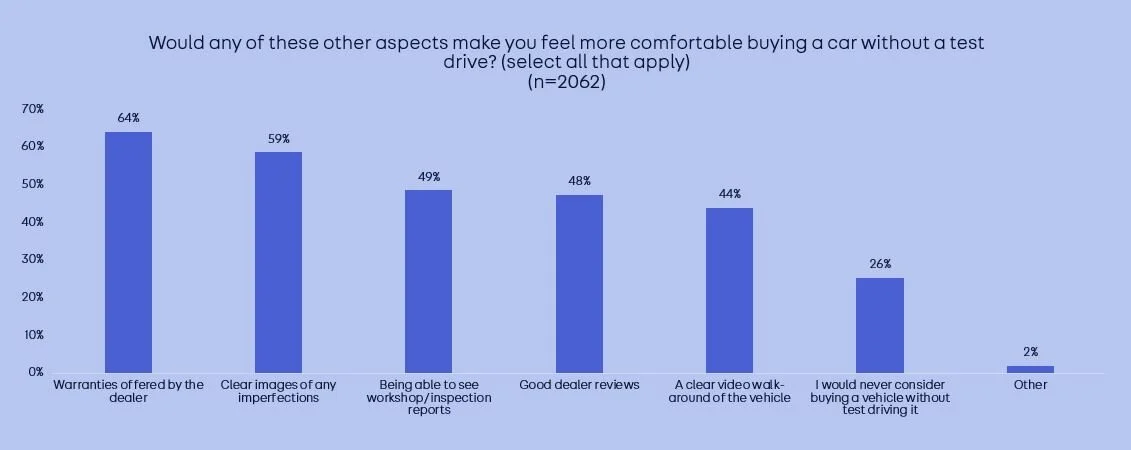Turning searches into sales without a test drive
Test drives. Are they legal under the current restrictions? With continued speculation and conflicting information, we explore how retailers are finding success without them in today’s market.
There is little doubt that consumers prefer to test drive a vehicle prior to purchase, in fact only 32% of consumers said they would be happy to buy a car without one¹. However, many retailers would agree that test drives can be inefficient, risky and expensive if not managed correctly. Especially during a pandemic where test drives should be unaccompanied, and vehicles are expected to be sanitised after every contact with a consumer.
What’s the purpose of providing a test drive?
The intended purpose is to allow the customer to qualify their purchase before the sale. The challenge is that test drives have become an expectation and consumers use them as part of the research process well in advance of their intended purchase. This is time-consuming and expensive for retailers, especially independents who have no obligation to provide them. If retailers are to succeed without them, they essentially need to provide three assurances:
The vehicle is in good condition and free from defects
The vehicle has been inspected and is mechanically sound
The vehicle can be returned for a refund or repair if it doesn’t meet the customer’s expectations
Are test drives necessary in today’s market?
Test drives still have a place, with no substitute for trying before you buy. However, in the current market where physical forecourts are closed and questions remain over the legality of offering test drives, they’re far from essential. In fact, many customers are finding success without them and some are experiencing record performance. The key is providing the customer with the confidence to commit to a purchase without a test drive, giving them the assurances that they have options if the car doesn’t live up to their expectations.
What do consumers think about buying without a test drive?
In a recent consumer survey, more than 2 in 3 consumers told us that they were unlikely to buy a car without a test drive¹. This swung significantly when we asked if they would buy the car without a test drive if they were offered a 14-day moneyback guarantee. In this instance, 65% said they would or probably would, with only 14% completely ruling it out².
We also asked customers what else would make them more comfortable buying without a test drive, with 64% selecting warranties offered by the dealer, 59% stating clear images of any imperfections, and 49% saying workshop inspection reports³.
How can I sell without a test drive?
In summary, if you want to maximise your opportunities to sell without a test drive:
Advertise with a 14-day moneyback guarantee
Promote your warranty to cover any failures (the longer the better)
Share a workshop inspection report or video with the buyer
Utilise video walkarounds and live viewings
What if customers insist on a test drive?
If a customer won’t commit to a purchase without a test drive, we suggest you take a holding deposit and build up your pipeline demand, until such time as you can offer test drives safely. If you wish to pursue the legality of offering a test drive in lockdown, you need to speak to your local trading standards office and follow their guidance. In addition, you must take a deposit prior to providing the test drive and have the adequate insurance to cover unaccompanied test drives.
How can retailers manage test drives better after lockdown?
Many retailers we’ve spoken to in recent weeks have told us that they won’t revert to their ‘old’ retailing methods when physical forecourts reopen. Trading under lockdown restrictions has given them more control over their buying process, enabling them to work smarter and more efficiently. The following retailing methods can help you manage test drives more effectively as forecourts reopen:
Make test drives appointment only - Ensure the customer knows the car they’re interested in before they arrive
Promote remote selling features - allow the customer to complete the deal online without a test drive
Take a holding deposit or reservation fee before the test drive - this should test the customer’s intent to purchase
Save time with unaccompanied test drives - Fit a self-installed tracker, restrict the test to a specified boundary and set a time limit of 20-30mins.
Offer a money-back guarantee as standard – Inform the customer about their right to return if they’re not completely satisfied.
¹Auto Trader on-site consumer survey Feb 2021 (n=2746) | ² Auto Trader on-site consumer survey Feb 2021 (n=2617) | ³ Auto Trader on-site consumer survey Feb 2021 (n=2062)



